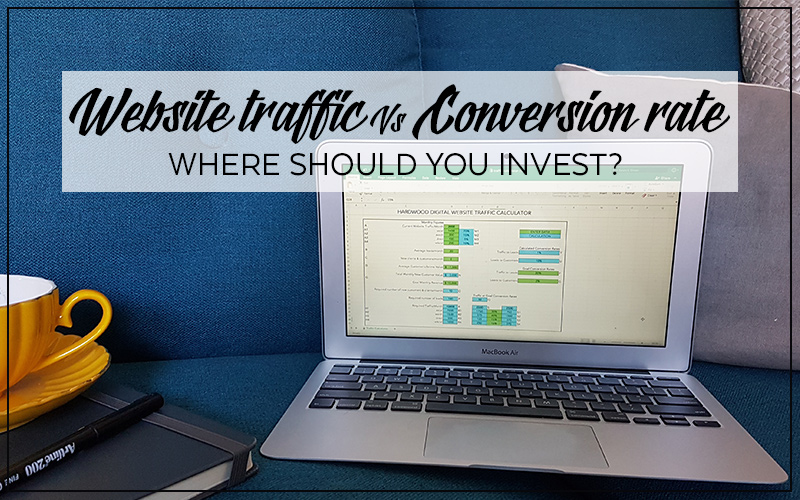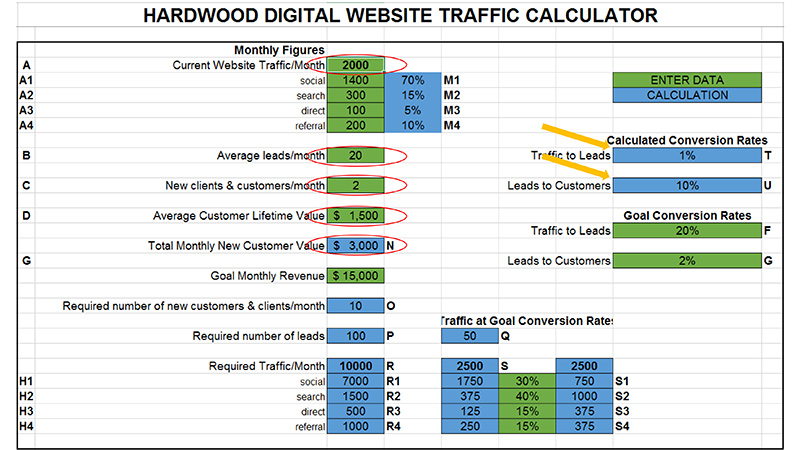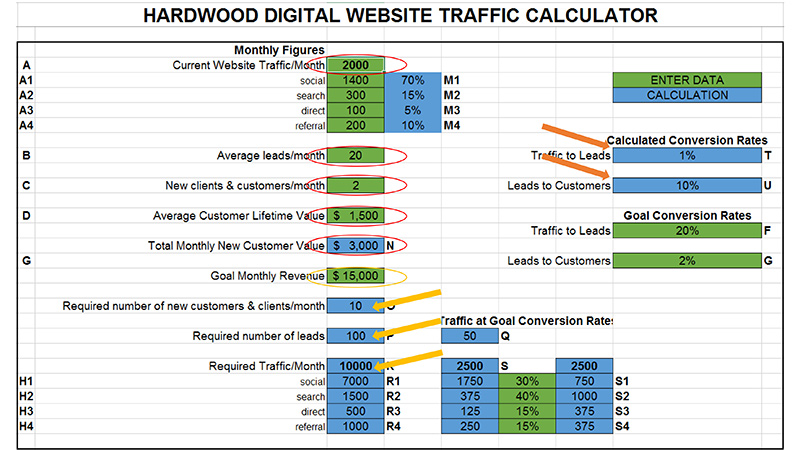Website Traffic Vs Website Conversion
Often businesses don’t see their website as being a growth tool. They think of it as an online CV or brochure, designed to show visitors what they do and as a first contact point on the internet. Information that someone can look at to gain some understanding of the business.
Websites designed as an online brochure won’t do a great job of converting visitors into leads and then leads into customers. New leads and customers, that’s the outcome you’re actually looking for with your business website. Beyond the lines of code and pretty pictures are two important facets of a website that performs well for a business.
- Website traffic
- Conversion rate
A website’s aesthetic is important, it needs to be visually appealing to a visitor. However, what’s really important is that your website’s got the information that your visitor is looking for. Content that’s going to attract visitors when they’re searching for the answer to a problem they might have.
There’s a lot more that we put into a website build that to really help our clients see return on their investment.
Want a hand working through the process below? Hit Tatum up for your complimentary 30-minute video call where we’ll set some website goals for your business.
First steps of website traffic analysis.
We start out by understanding:
- About the business,
- Who is the client,
- What problems does the business solve for the client, and
- How do they do that?
All of this information needs to be really clear on a website.
Once we’re clear on these points we assess how the website is performing for the business right now.
You might not be happy with the performance but that doesn’t mean that the whole website needs to be rebuilt or redesigned or you need new photos or anything like that.
Sometimes it just needs a few tweaks.
Depending on how old the website is and the type of information on there, you may need a significant expansion or you may need a complete rebuild, but to begin with we need to assess where you’re at right now.
The first thing we need to do is find out how much traffic are you currently getting to your website.
It’s not uncommon for a new website to be launched and the business owner then expects a flood of new leads because they’ve just had this new website launched. They’ll share it to social media one or two times, it’s there on their business card, but all they get is a trickle.
How much traffic is your website getting now?
In order to generate business from your website, you need to be getting traffic to it. One of the first things we need to understand is how much traffic you need in order to achieve your business goals.
You can download the website traffic calculator for yourself below and work through each of the steps with me.
Having your own copy of the calculator will help you better understand what each step means as I illustrate them to you.
Let’s start by looking at where an imaginary business is right now. Let’s analyse the website for Gerald’s Gadgets.
Gerald is getting 2,000 website visitors a month.
Let’s not worry about whether they’re unique visits or multiple visits or any of that, but let’s say there’s 2,000 hits on his website a month.
From this, he’s getting 20 leads.
What a lead is will be different for different types of businesses. It might be:
- A phone enquiry or booking,
- A contact form submission,
- An email list opt in
- A first time purchase.
Let’s say Gerald gets 20 leads a month.
From his 20 leads, Gerald gets two new clients or customers a month.
The average customer lifetime value is $1,500. Based on this Gerald has a total monthly new customer value of $3,000. To keep things simple, an average customer only buys from Gerald once and they spend $1,500.
We can show clearly that from 2,000 visitors to the Gerald’s Gadgets website each month Gerald is generating $3,000 revenue.
Where is your website traffic coming from?
We can also break down the sources of traffic into four key areas:
- Organic
- Referred
- Direct
- Social
Knowing where the traffic is coming from is helpful in understanding how effective each traffic channel is for a business. It also provides a baseline from which a client can build and enables us to understand what changes will have the greatest impact on progressing a client towards their goals.
What is the conversion rate of your website traffic?
Returning to Gerald’s website we can calculate that 1% of website traffic is converted to a lead. From those leads, 10% convert to customers.
Conversion metrics are important to understand at this point because it tells us how well a website is performing at converting visitors to new leads and then leads to customers. If conversion rates are low compared to industry norms then the first work to be done will be website conversion rate optimisation. If the conversion rates look good then focus goes immediately to acquiring more traffic.
How much website traffic does your business really need?
We understand where Gerald is right now in his business and how that relates to his website.
What we need to do next is understand what his business goals are and what part his website plays in that.
Gerald has a goal of achieving consistent monthly revenue of $15,000 within 12 months. Revenue that’s derived directly from his website. That’s five times what he’s achieving now. But, assuming that the market exists (a key point we would have already established) we can develop a clear strategy for achieving that outcome.
Consider what’s required at current conversion rates.
$15,000 value will require 10 new customers per month.
To get 10 customers Gerald needs about 100 leads.
Working backwards, at those same conversion rates, 100 leads requires about 10,000 website visits each month. Increasing from 2,000 to 10,000 is a big step change. How achievable it is within a given time frame will be dependent on a variety of factors. Including
- Size of market
- Available budget to achieve the desired outcome
- Existing digital assets (social media following, number of blog posts, email database size).
For businesses that cater to a mass market achieving that sort of jump in traffic is going to be somewhat easier than for a more specialised, niche business. At this point what we do is assess each business on a case basis. Based on our understand of how easy or difficult it’s going to be to achieve that traffic we’ll recommend the best next steps.
In Gerald’s case, regardless of how easy or difficult it’s likely to be to achieve the increased website traffic, I’d recommend starting with some conversion rate optimisation work. His visitor to lead conversion rate is low but he does send emails to his list twice weekly, meaning that his lead to customer conversion rate is reasonable. However, there is room for improvement with a more targeted approach to lead nurturing.
Should you focus on website traffic or conversion rate first?
We can see in Gerald’s case that his conversion rates are on the low side so what we’re going to do is consider some different goal conversion rates. When you’ve downloaded your own traffic calculator that you can play around with your own conversion rates and understand how big and impact they can have.
Talking about what is a good or a bad conversion rate is irrelevant because it’s variable for different industries.
In Gerald’s case, let’s assume that achieving 2% traffic to leads is a good conversion rate and considered achievable in his industry. Improvements in Gerald’s sales process could mean 20% of those leads convert to customers. We go from having 2% of the traffic who become leads, and then 20% of those leads become customers.
Doubling both of Gerald’s conversion rates means that he could be achieving his revenue target with only a 25% increase in traffic to 2,500 visitors a month.
Conversion Rate Optimisation
Having established that website conversion rate optimisation (CRO) is the first step towards achieving Gerald’s goals we develop a working plan.
To improve conversion rate a number of elements are considered and addressed in order of expected impact. A conversion rate optimisation plan for a business could include items like:
- Website redesign
- Copywriting
- Calls to action
- Deeper traffic analysis to assess the quality of traffic the business is currently getting
- Email nurturing for leads
- Split testing
- Ongoing optimisation activities
Depending on the style of website, particularly with our previous clients because we know how they’ve been built, we’re familiar with, we can undertake a continuous improvement process so that website is not just developed as a one hit wonder. A website is something that should be worked on to achieve continuous improvement based on data collected.
Every website needs a traffic plan. A traffic plan forms part of your complete digital marketing strategy and details the activities you should be undertaking in each of the four areas that traffic might be and this relates to those four key areas that traffic comes from, social media, your organic search, referred traffic, and direct traffic, and there’s that continuous improvement process that we can follow-up with on an ongoing basis.
Website Traffic
Developing and implementing a traffic strategy for Gerald would work hand in hand with the conversion rate optimisation work. The purpose of a good website traffic strategy is to attract visitors to the website that are more likely to convert into leads and customers. There are a variety of different tactics that you can use to target and attract the traffic you are looking for. Understanding how much traffic you actually want and what it’s worth to you will help assign an online marketing budget to each area.
Tactics to try might include:
- Search Engine Optimisation (SEO)
- Social media
- Paid online advertising (EG Facebook, Adwords)
- PR
- Writing for industry related websites
- Sponsored content produced by online influencers
The key with traffic is not only to attract enough website traffic to meet business goals but to also attract visitors who are more likely engage your services or buy your product.
What are the next steps?
What this video and blog post have covered is a basic evaluation of how to:
- Get traffic to your website.
- Understand your conversion rates and
- Put a plan in place to achieve your goals.
You’ll find the link to download the website traffic calculator for yourself below.
If you have any questions, don’t hesitate to shoot us an email and get in touch. Alternatively you can fill in the form below to book a strategy session.
We’re more than happy to have a complimentary session with you where we work through this to help you understand what kind of traffic you need to get to your website, and what kind of goals are attainable for you.
That’s a really good first conversation to have.
[caldera_form id=”CF57552a973c14a”]





